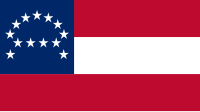9th Louisiana Infantry
The Louisiana Tigers was the common nickname for certain infantry troops from the state of Louisiana in the Confederate States Army during the American Civil War. Originally applied to a specific company, the nickname expanded to a battalion, then to a brigade, and eventually to all Louisiana troops within the Army of Northern Virginia. Although the exact composition of the Louisiana Tigers changed as the war progressed, they developed a reputation as fearless, hard-fighting shock troops.
The origin of the term came from the "Tiger Rifles," a volunteer company raised in the New Orleans area as part of Major Chatham Roberdeau Wheat's 1st Special battalion, Louisiana infantry. A large number of the men were foreign-born, particularly Irish Americans, many from the city's wharves and docks. Many men had previous military experience in local militia units or as filibusters. They (and the regiments that later became known as the Tigers) were organized and trained at Camp Moore.
Originally, Company B of Wheat's Tigers wore distinctive uniforms similar to the French zouave, with straw hats or red cloth fezzes, blue-striped chasseur-style pants, and short dark blue jackets with red lacing or tombeaux. As time went on, this garb was replaced by Confederate uniforms and what clothing the men could purchase or otherwise obtain from civilians. Within months of arriving in Northern Virginia, Wheat's entire five-company battalion began to be called the Louisiana Tigers. The battalion first saw combat during the First Battle of Manassas, where it anchored the left flank on Matthews Hill for several hours until reinforcements arrived.
...
Wikipedia

